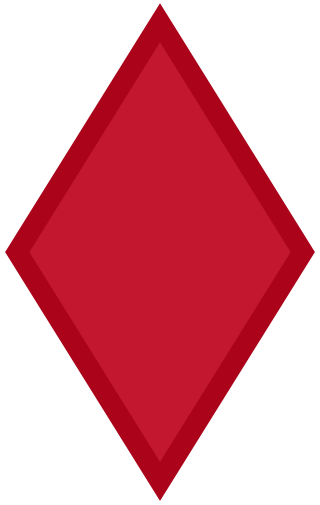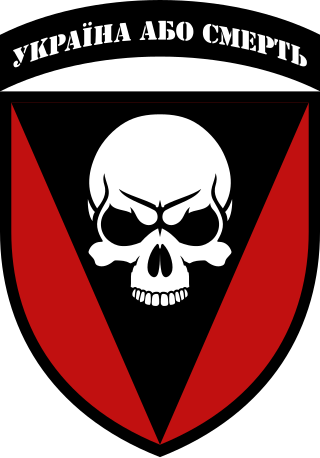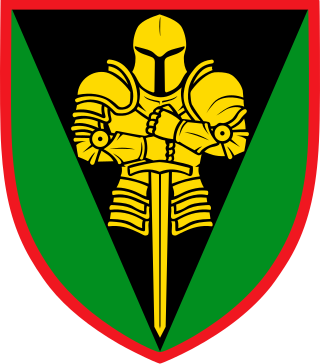
The Namibian Defence Force (NDF) comprises the national military forces of Namibia. It was created when the country, then known as South West Africa, gained independence from apartheid South Africa in 1990. Chapter 15 of the Constitution of Namibia establishes the NDF and defines its role and purpose as, " ... to defend the territory and national interests of Namibia".
A division is a large military unit or formation, usually consisting of between 10,000 and 25,000 soldiers. In most armies, a division is composed of several regiments or brigades; in turn, several divisions typically make up a corps.

A brigade is a major tactical military formation that typically comprises three to six battalions plus supporting elements. It is roughly equivalent to an enlarged or reinforced regiment. Two or more brigades may constitute a division.

The 5th Infantry Division (Mechanized)—nicknamed the "Red Diamond", or the "Red Devils" —was an infantry division of the United States Army that served in World War I, World War II and the Vietnam War, and with NATO and the U.S. Army III Corps. It was deactivated on 24 November 1992 and reflagged as the 2nd Armored Division.

The South African Army is the principal land warfare force of South Africa, a part of the South African National Defence Force (SANDF), along with the South African Air Force, South African Navy and South African Military Health Service. The Army is commanded by the Chief of the Army, who is subordinate to the Chief of the SANDF.

The Croatian Army is the land force branch of the Croatian Armed Forces. It is numerically the largest of the three branches of the Croatian Armed Forces. The HKoV is the main force for the defense of the country against external threats, and in addition to the task of defending the Republic of Croatia, the HKoV also has the task of participating in peace support operations and humanitarian operations as part of international forces, as well as the task of preventing and eliminating the consequences of emergency situations in the country caused by natural and technical accidents and disasters.

The South West Africa Territorial Force (SWATF) was an auxiliary arm of the South African Defence Force (SADF) and comprised the armed forces of South West Africa from 1977 to 1989. It emerged as a product of South Africa's political control of the territory which was granted to the former as a League of Nations mandate following World War I.

The 72nd Mechanized Brigade named after theBlack Zaporozhians is a formation of the Ukrainian Ground Forces. It was previously named the 29th Rifle Division and then the 72nd Guards Rifle Division of the Soviet Ground Forces. In 1957, it became a motor rifle division.

The 17th Heavy Mechanized Brigade is a brigade of the Ukrainian Ground Forces formed in 1940. The full name of the brigade is the 17th Separate Kryvorizka Heavy Mechanized Brigade, named after Kostiantyn Pestushko.

The 93rd Separate Mechanized Brigade "Kholodnyi Yar" is a formation of the Ukrainian Ground Forces formed in 1992. It has been described as "one of the most brutally effective" of Ukraine’s front-line brigades.

The 92nd Assault Brigade "Ivan Sirko", abbreviated 92 OShBr, is a formation of the Ukrainian Ground Forces. Its honorific name is after Cossack military leader Ivan Sirko. The unit was formed in 1999 as the 6th Mechanized Division based on the 6th Division of the National Guard of Ukraine. In 2000 it was reorganized as the 92nd Mechanized Brigade. Following the Russo-Ukrainian war and the 2015 decommunization in Ukraine, the brigade's Soviet honors and heritage were purged.

Mechanized Infantry Forces of Ukraine are the general basis and primary combat formations of the Ukrainian Ground Forces. They execute tasks of holding the occupied areas, lines and positions tasks of enemy's impacts repelling, of penetrating the enemy's defense lines, defeating the enemy forces, capturing the important areas, lines and objectives, Capture and expel enemy forces from territory and can operate in structure of marine and landing troops.

The 22nd Mechanized Brigade is a formation of the Ukrainian Ground Forces. It traces its origins to the 66th Guards Rifle Division, originally a formation of the Red Army and later of the Soviet Ground Forces.
Victor Simunja is a Namibian politician. A member of the South West Africa People's Organization (SWAPO), Simunja was appointed to the National Assembly of Namibia in 2000 and served as Deputy Minister of Defense from 2000 to 2009. Simunja rose to the rank of lieutenant colonel in the Namibian Defence Force prior to entering political office. He is a member of the Mafwe ethnic group, indigenous to the Caprivi Strip.

The Namibian Army is the ground warfare branch of the Namibian Defence Force.
4 Artillery Brigade, colloquially known as "Gunners", is the artillery arm of the Namibian Army based at Otjiwarongo. It functions as the Army's artillery Formation and hosts all the Artillery regiments of the Army.
12 Motorised Infantry Brigade(pronounced as One Two Motorised Infantry Brigade) is a brigade of the Namibian Army based at Keetmanshoop. The prefix "12" is taken from 12 May 1929, Namibia's first president's birthday day. The brigade is responsible for the defence of the southern areas of Namibia. Its subordinate units are situated in the Omaheke, Hardap, Karas and Erongo regions.
26 Motorised Infantry Brigade(pronounced as Two Six Motorised Infantry Brigade) is a brigade of the Namibian Army based at Grootfontein. The prefix "26" is taken from 26 August 1966, the day on which SWAPO guerrillas first encountered the South African security forces at Ongulumbashe. The brigade is responsible for defence of the Northern areas of Namibia. Its subordinate units are situated in Zambezi, Kavango, Omusati, Kunene and Oshana regions.
Brigadier General Erastus Nomongula Kashopola is a retired Namibian military officer. His last command was as the General Officer Commanding 21 Motorised Infantry Brigade.

















